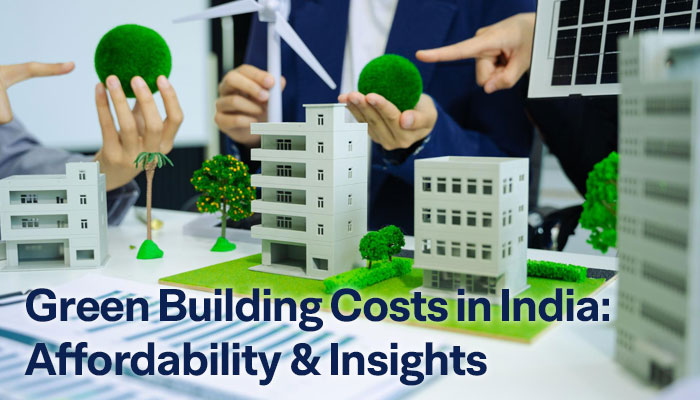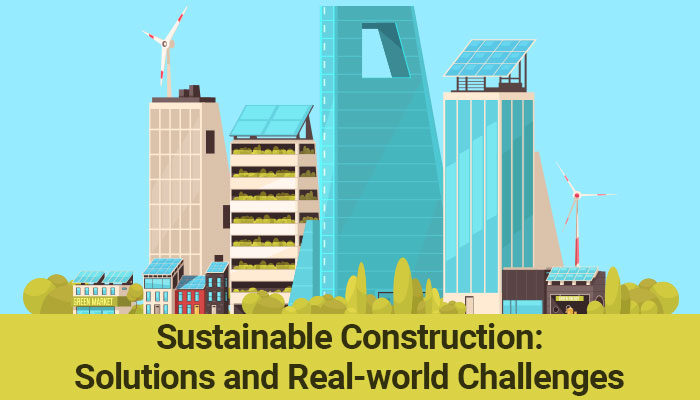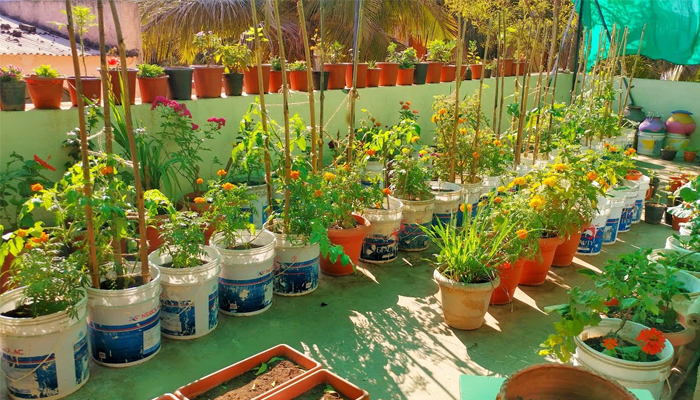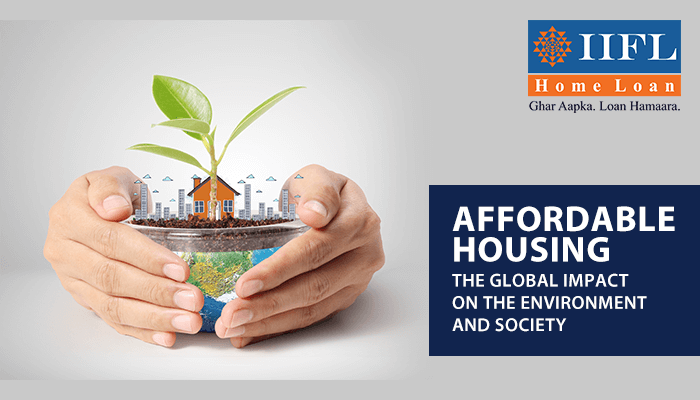The Urgent Need of Green Finance to Support Affordable Housing

Government’s Goal Towards Carbon Free India
India’s Panchamrit Climate Action plan aspires to reduce the carbon emissions by improving energy efficiency, use of non-fossil fuels, and renewable sources. It is committed towards the long term goal of achieving Net zero emissions by 2070. To fuel this transition, it is imperative that sustainability is adopted at the grass-root level, especially in the major sectors contributing highest to carbon emissions. The construction industry contributes to almost 40% of the carbon emissions. Thus it is necessary to strategize and mandate the vastly growing sector while protecting the vulnerable sectors of economy and segments of our society.
It has become essential for the underprivileged class to have shelter of their own which is affordable as well as sustainable to balance the negative impact caused by mass construction. There is a huge demand for affordable housing but the weaker sections of society have no access to bank funding. The Affordable Housing Finance Companies have bridged the gap in demand and supply to a great extent.
Affordable Housing in India
Pradhan Mantri Awas Yojana (PMAY) is an initiative by Government of India that aims to provide affordable housing in urban and rural areas of India. This has boosted the construction of affordable housing projects pan India. However, for such a mass construction of housing which is affordable, evades the quality control and efficient housing. For buildings having a lock-in period of more than 40 years, this has a negative impact on the environment if not properly planned or constructed. Thus it is necessary to ensure that these projects are green while being affordable. To ensure this, there is need for additional or a special finance for these projects. Green finance is one such opportunity for the affordable housing developers to explore. The increasing demand for affordable housing which is also green creates urgency for accessibility of green finance in the country.
What is Green Finance?
The term ‘Green finance’ refers to the financial arrangements that are specific to the use for projects that are environmentally sustainable or projects that adopt the aspects of climate change. New financial instruments such as carbon market instruments i.e. carbon tax and green bonds are made available to fund such projects by new financial institutions like green banks. They together constitute green finance. While carbon tax is levying a cost on the carbon emissions and for the use of fossil fuels, green bonds are the bonds issued towards proceeds used for sustainable and environment friendly projects.
Green finance for housing in the affordable sector will open doors to address the ever increasing market of affordable housing. Green homes not only offer sustainable living to the home buyers but also offers tax benefits, reduced utility bills, thermal comfort and some banks even offer reduced ROI on the home loans. Developers get the opportunity to stand out from others while enjoying the perks of higher Floor Space Index (FSI), faster sales, higher sales price and elevated social status. Many financial institutions have adopted the model where they fund green and affordable projects at special reduced rates and other benefits. Investing in green finance grants them lower default rates and higher resale value.
With the increasing demand for housing, especially in the affordable housing, this sector has a huge scope to become one of the biggest contributors to increase carbon emissions. A report by IFC estimates that out of around INR 10,676 crores of total investment in green building, residential sector has a larger chunk.
SUNREF in India
The Intended Nationally Determined Contribution (INDC) goals by India have accelerated the green growth in the country. It is estimated that India needs at least $2.5 trillion in capital to meet its ambitious climate actions between 2015 and 2030. Thus, private investors and international agencies have to pool in a significant portion to meet these targets.
Financing this green growth is a major challenge for developing countries like India. Launched in 2017, the SUNREF (Sustainable Use of Natural Resources and Energy Finance) program developed by the French Development Agency (AFD) extended technical assistance and funding to local financial institutions. These financial institutions further financed small and medium-size projects of public and private promoters.
Other Funding Lines in the Private Sector
The Asian Development Bank (ADB) and IIFL Home Finance Limited (IIFL HFL) have entered into an agreement for technical assistance (TA) of one million dollars to help promote green and affordable housing solutions in India. This TA will actively promote and create awareness among developers and other stakeholders in the affordable housing market on climate risk mitigation, adaptation, and green-certified housing standards.
Gaps in Affordable Housing and Green Finance
The green finance market is still at a nascent stage in India. Many non-metropolitan regions still lack awareness about green buildings and green funding. The acceptance by affordable housing developers to adopt green strategies is yet to be established. Green housing is still considered to be an expensive affair over the benefits offered against it. The developer mindset needs to positively change towards the environment. The mandates for Environmental Clearance are at times considered as an additional capital cost and not as a basic facility required in the project. This reflects the void of social responsibility in many developers especially in the affordable housing sector towards safeguarding the environment. There is lack of supplier acceptance dedicated to environmental protection, and ethical or sustainability-related investment principles.
By incentivizing local lenders to finance construction as well as purchase of affordable green homes, green finance in affordable housing can be propagated effectively. Although India has some credit lines supporting such lenders, there are still some challenges that need to be addressed for encouraging green finance. The documentation and verification process needs to understanding of the cultural, economic, political, environmental and social context of the country. The on-ground reality is different from any idealistic scenarios and very often it is not addressed by any laws or policies.
The ever expanding housing sector is gradually accepting this new form of affordable and green housing. It still holds a good potential of development towards stringent and sustainable practices, benefiting the developer as well as the home buyer. It is time that sustainability should be considered a part of necessity and is the foundation of any project that is built.
References
-
https://marcellus.in/newsletter/kings-of-capital/the-rise-of-affordable-housing-finance-in-india/
-
https://rbidocs.rbi.org.in/rdocs/Bulletin/PDFs/04AR_2101202185D9B6905ADD465CB7DD280B88266F77.PDF
-
https://development.asia/explainer/green-finance-explained (Asian Development Bank)
-
https://www.diva-portal.org/smash/get/diva2:1532467/FULLTEXT01.pdf
Tags
Disclaimer: The information contained in this post is for general information purposes only. IIFL Home Finance Limited (including its associates and affiliates) ("the Company") assumes no liability or responsibility for any errors or omissions in the contents of this post and under no circumstances shall the Company be liable for any damage, loss, injury or disappointment, etc. suffered by any reader. All information in this post is provided "as is", with no guarantee of completeness, accuracy, timeliness, or of the results, etc. obtained from the use of this information, and without warranty of any kind, express or implied, including, but not limited to warranties of performance, merchantability, and fitness for a particular purpose. Given the changing nature of laws, rules, and regulations, there may be delays, omissions, or inaccuracies in the information contained in this post. The information on this post is provided with the understanding that the Company is not herein engaged in rendering legal, accounting, tax, or other professional advice and services. As such, it should not be used as a substitute for consultation with professional accounting, tax, legal or other competent advisers. This post may contain views and opinions which are those of the authors and do not necessarily reflect the official policy or position of any other agency or organization. This post may also contain links to external websites that are not provided or maintained by or in any way affiliated with the Company and the Company does not guarantee the accuracy, relevance, timeliness, or completeness of any information on these external websites. Any/ all (Home/ Loan Against Property/ Secured Business Loan/ Balance Transfer/ Home Improvement Loan/ NRI Home Loan/ Home Loan for Uniformed Services) loan product specifications and information that may be stated in this post are subject to change from time to time, readers are advised to reach out to the Company for current specifications of the said (Home/ Loan Against Property/ Secured Business Loan/ Balance Transfer/ Home Improvement Loan/ NRI Home Loan/ Home Loan for Uniformed Services) loan.
 Login
Login






















